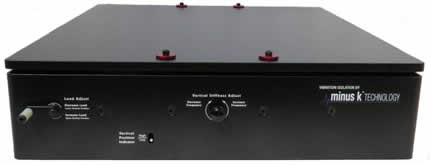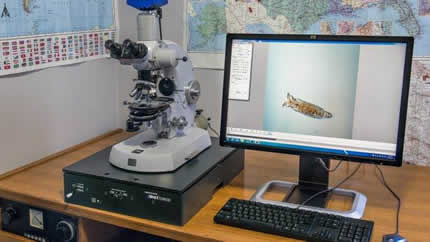
Apogee Photo Magazine - August 2017
Negative-Stiffness Vibration Isolation
for the
Sharpest Micro-World Images
 Photomicrography is the method by which images, magnified through a microscope, are collected by a camera. These images often represent subjects ranging in size from less than 1 millimeter (mm) to 1 - 2 centimeters (cm). This is opposed to a macrographic image, which is at a scale that is visible to the naked eye.
Photomicrography is the method by which images, magnified through a microscope, are collected by a camera. These images often represent subjects ranging in size from less than 1 millimeter (mm) to 1 - 2 centimeters (cm). This is opposed to a macrographic image, which is at a scale that is visible to the naked eye.
Used extensively in research applications by professionals, photomicrography has a strong and growing appeal with enthusiast photographers, who find micro-world images of pond water specimens or the crystalline structure of gems both fascinating and beautiful. But what is required to take advantage of this micro-world is more than simply attaching a camera to the optical path of a microscope. The best photomicrographs present an image of a specimen with good exposure in both highlights and shadowed areas, excellent color saturation, and with sharp and crisp details.
Improper focus or blurry images represent the largest source of errors in photomicrography, and much of this is caused by vibrations. Vibrations can cause loss of detail by blurring the image.
A photomicrograph that is not properly focused could be caused by improper adjustment of lens focusing, mechanical shutter movement, manipulation of the microscope, or due to ambient vibrations transmitted through the table or floor up through to the microscope and onto the specimen being photographed. Of these, the most challenging to resolve is ambient vibrations.
Ambient Vibrations
Ambient vibrations can be caused by a multitude of factors. Every structure is transmitting noise. Within the home or building itself, the heating and ventilation system, fans, pumps and elevators are just some of the mechanical devices that create vibration. Movement of people within the structure is another source of vibrations.
Depending on how far away the camera and microscope set-up is from these vibration sources, and where in the structure the set-up is located, whether on the third floor or in the basement, for example, will determine how strongly the photomicrography will be influenced. External to the structure, the camera and microscope set-up can be influenced by vibrations from vehicle movement, nearby construction, noise from aircraft, and even wind and other weather conditions can cause movement of the structure.
“Anything that reduces vibration in photomicrography will improve the image results,” said Bruce Girrell of Traverse City, Michigan, a serious enthusiast of photomicrography. “The tiniest vibrations get magnified. Very often when I am working with a camera mounted to a microscope, it is difficult to focus because of vibrations coming up through the table and floor. Anything that can be done to eliminate ambient vibrations contributes to image clarity.”
Girrell photographs a lot of tiny things, like bugs and pond water critters - single-cell organisms like rotifers.
He uses a variety of cameras for shooting these little things. Such as his Nikon D800, 36.3 megapixel digital SLR camera. Girrell also uses a PAXcam™ 5.0 megapixel digital microscope camera, with a 2/3rds CCD sensor and 2448 x 2048 image resolution. As well as a Zeiss AxioCam® HRc 13 megapixel, high-resolution microscope digital camera, with microscanning.
 “If I didn’t have vibration isolation, my specimen droplets of pond water, for example, being viewed through the microscope and camera, would take forever to settle out before being able to get a sharp image,” added Girrell.
“If I didn’t have vibration isolation, my specimen droplets of pond water, for example, being viewed through the microscope and camera, would take forever to settle out before being able to get a sharp image,” added Girrell.
Shock-absorbing anti-vibration mounts, or rubber pads placed underneath the microscope, can be used to help prevent vibrations from reaching the specimen being photographed. These, however, offer very limited vibration isolation, and are inadequate to eliminate vibrations sufficiently to achieve consistent sharp images.
Air tables, although a step up from anti-vibration mounts and pads, still are not capable of providing adequate vibration isolation of the critical low-frequency hertz (Hz) vibrations coming through the structure of a house or building. Plus, their bulky size, need for an air compressor and connective hosing, and poor portability make air tables a less than optimum solution for photomicrography enthusiasts.
Girrell’s choice for eliminating ambient vibrations is Negative-Stiffness vibration isolation.
“For the serious photomicrography enthusiast, Negative-Stiffness vibration isolation is the ultimate choice for eliminating ambient vibrations,” continued Girrell.
Designed and engineered by Minus K Technology (www.minusk.com), Negative-Stiffness vibration isolation technology is widely used in microscopy, nanotechnology, biological sciences, semiconductors, materials research, zero-g simulation of spacecraft, and high-end audio. Research groups in more than 300 leading universities and government laboratories in 50 countries use Negative-Stiffness vibration isolation.
“From a technical perspective, what is very advantageous about Negative-Stiffness isolators is that they achieve a high level of isolation in multiple directions,” Girrell added.
Negative-Stiffness isolators have the flexibility of custom tailoring resonant frequencies at 0.5 Hz* vertically and horizontally (with some versions at 1.5 Hz horizontally).
(*Note that for an isolation system with a 0.5 Hz natural frequency, isolation begins at 0.7 Hz and improves with increase in the vibration frequency. The natural frequency is more commonly used to describe the system performance.)
 Vertical-motion isolation is provided by a stiff spring that supports a weight load, combined with a Negative-Stiffness mechanism. The net vertical stiffness is made very low without affecting the static load-supporting capability of the spring. Beam-columns connected in series with the vertical-motion isolator provide horizontal-motion isolation.
Vertical-motion isolation is provided by a stiff spring that supports a weight load, combined with a Negative-Stiffness mechanism. The net vertical stiffness is made very low without affecting the static load-supporting capability of the spring. Beam-columns connected in series with the vertical-motion isolator provide horizontal-motion isolation.
A beam-column behaves as a spring combined with a negative-stiffness mechanism. The result is a compact passive isolator capable of very low vertical and horizontal natural frequencies and very high internal structural frequencies.
Vibration transmissibility is a measure of the vibrations that are transmitted through the isolator relative to the input vibrations. Negative-Stiffness isolators, when adjusted to 0.5 Hz, achieve 93 percent isolation efficiency at 2 Hz; 99 percent at 5 Hz; and 99.7 percent at 10 Hz.
Negative-Stiffness isolators resonate at 0.5 Hz. At this frequency there is almost no energy present. It would be very unusual to find a significant vibration at 0.5 Hz. Vibrations with frequencies above 0.7 Hz (where negative-stiffness isolators begin isolating) are rapidly attenuated with increases in frequency.
Utilizing the Full Potential of Photomicrography
Precision optical elements, and highly-advanced digital camera sensors and processors, are capable of delivering extremely detailed images of micro-world elements which are largely unavailable to the naked eye. Without equally precise isolation of ambient vibrations, however, these technological advances in photography - and specifically photomicrography - unfortunately cannot be fully realized.
For those enthusiasts serious about their photomicrography, recognizing the possible sources of out-of-focus images is a critical step to improving their clarity and sharpness. To produce such high-quality images, ambient vibrations need to be addressed and isolated. Only then can the full wonder of the micro-world be visualized in images.
About Minus K Technology, Inc.
Minus K® Technology, Inc. was founded in 1993 to develop, manufacture and market state-of-the-art vibration isolation products based on the company’s patented Negative-Stiffness technology.
Minus K products are used in a broad spectrum of applications including microscopy, nanotechnology, biological sciences, semiconductors, materials research, zero-g simulation of spacecraft, and high-end audio. The company is an OEM supplier to leading manufacturers of scanning probe microscopes, micro-hardness testers and other vibration-sensitive instruments and equipment. Minus K customers include private companies and more than 300 leading universities and government laboratories in 50 countries.
Dr. David L. Platus is the inventor of Negative-Stiffness isolators, and President and Founder of Minus K Technology, Inc. (www.minusk.com). He earned a B.S. and a Ph.D. in Engineering from UCLA, and a diploma from the Oak Ridge School of (Nuclear) Reactor Technology.
Prior to founding Minus K Technology he worked in the nuclear, aerospace and defense industries conducting and directing analysis and design projects in structural-mechanical systems. He became an independent consultant in 1988. Dr. Platus holds over 20 patents related to shock and vibration isolation.
|